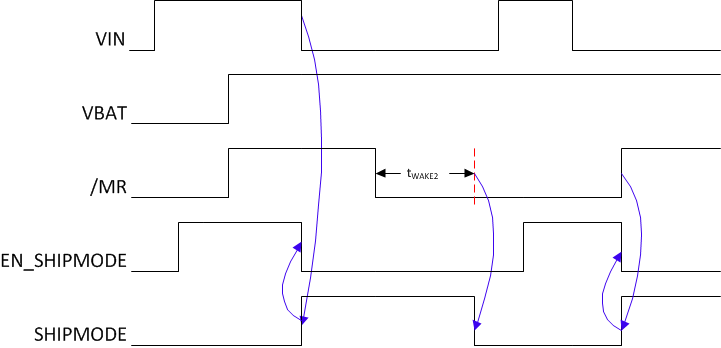ZHCSJD3C july 2018 – april 2023 BQ25150
PRODUCTION DATA
- 1
- 1 特性
- 2 应用
- 3 说明
- 4 Revision History
- 5 说明(续)
- 6 Device Key Default Settings
- 7 Pin Configuration and Functions
- 8 Specifications
-
9 Detailed Description
- 9.1 Overview
- 9.2 Functional Block Diagram
- 9.3
Feature Description
- 9.3.1 Linear Charger and Power Path
- 9.3.2 Protection Mechanisms
- 9.3.3 ADC
- 9.3.4 VDD LDO
- 9.3.5 Load Switch / LDO Output and Control
- 9.3.6 PMID Power Control
- 9.3.7 MR Wake and Reset Input
- 9.3.8 14-Second Watchdog for HW Reset
- 9.3.9 Faults Conditions and Interrupts ( INT)
- 9.3.10 Power Good ( PG) Pin
- 9.3.11 External NTC Monitoring (TS)
- 9.3.12 External NTC Monitoring (ADCIN)
- 9.3.13 I2C Interface
- 9.4 Device Functional Modes
- 9.5 Register Map
- 10Application and Implementation
- 11Power Supply Recommendations
- 12Layout
- 13Device and Documentation Support
- 14Mechanical, Packaging, and Orderable Information
9.4.1 Ship Mode
Ship Mode is the lowest quiescent current state for the device. Ship Mode latches off the device and BAT FET until VIN > VUVLO or the MR button is depressed for tWAKE2 and released. Ship mode can be entered regardless of the state of CE. The device will also enter Ship Mode upon battery insertion when no valid VIN is present. If the EN_SHIPMODE is written to a 1 while a valid input supply is connected, the device will wait until the IN supply is removed to enter ship mode. If the MR pin is held low when the EN_SHIPMODE bit is set, the device will wait until the MR pin goes high before entering Ship Mode. shows this behavior. The battery voltage must be above the maximum programmable VBATUVLO threshold in order to exit Ship Mode with MR press. The EN_SHIPMODE bit can be cleared using the I2C interface while the VIN input is valid. The EN_SHIPMODE bit is not cleared upon the I2C watchdog expiring, this means that if watchdog timer fault occurs while the EN_SHIPMODE bit is set and the device is waiting to go into Ship Mode because VIN is present or MR is low, the device will still proceed to go into Ship Mode once those conditions are cleared. The following list shows the functions that are active during Ship Mode:
- VIN_UVLO Comparator
- MR Input
 Figure 9-13 Ship Mode Entry Based on
EN_SHIPMODE Bit
Figure 9-13 Ship Mode Entry Based on
EN_SHIPMODE Bit